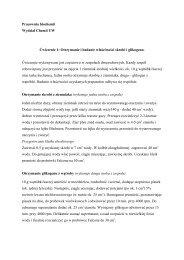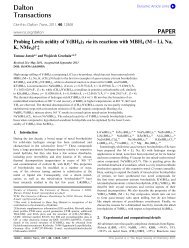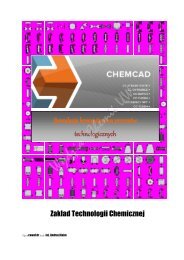Chem. Anal. (Warsaw), 53, 759
Chem. Anal. (Warsaw), 53, 759
Chem. Anal. (Warsaw), 53, 759
Create successful ePaper yourself
Turn your PDF publications into a flip-book with our unique Google optimized e-Paper software.
776 Z. Hubicki, M. Wawrzkiewicz and A. Wo³owicz<br />
dimethylglyoxal bis(4-phenyl-3-thiosemicarbazone) (DMBS) (Fig. 21) into the<br />
Amberlite XAD–7 matrix [48].<br />
Figure 21. DMBS structure<br />
The platinum group metal ions were eluted with small volumes of N,N-dimethylformamide.<br />
Good results in preconcentration of microquantities of Pd(II) onto the<br />
modified Amberlite XAD–1 and XAD–16 were obtained.<br />
Chitosan and its derivatives modified with glutaraldehyde, rubeanic acid, epichlorhydrin,<br />
and thiourea are of great interest [51–57]. Chitosan is the aminopolysaccharide<br />
obtained by deacylation of chitin. N donor atoms are responsible for sorption of many<br />
metal ions including PGM, depending on pH and concentration of the solution. Modification<br />
processes of chitosan are of great importance because of its good solubility<br />
in many acids. Cross-linking of chitosan with glutaraldehyde via the imine bond<br />
between the amine groups of biopolymer and the aldehyde groups of the modifier<br />
(Schiff reaction) leads to the selective sorbent (GCC) for Pd(II) ions of the ion<br />
exchange capacity of 180 mg g –1 GCC (~2 mmol g –1 GCC) [51].<br />
Pd(II) sorption from chloride solutions depends not only on Cl – concentration but<br />
also on the type and concentration of palladium anion complexes.<br />
Palladium may be also recovered by destructive procedure including burning or<br />
mineralization of chitosan with hydrogen peroxide after the acidic treatment.<br />
Baba et al. [58] proposed the following reaction mechanism:<br />
RNH 2 + H + , Cl – � RNH +<br />
3 Cl–<br />
2RNH +<br />
3Cl– + PdCl2– � (RNH+<br />
4 3 ) 2PdCl2– + 2Cl–<br />
4<br />
The affinity series of chitosan sorbents modified with rubeanic acid (RADC),<br />
thiourea (TGC), and glutaraldehyde (GCC) for Pd(II) ions is as follows:<br />
(9)<br />
(10)







